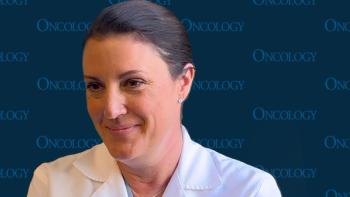
- ONCOLOGY Vol 15 No 12
- Volume 15
- Issue 12
A Breast Cancer Journey
A comprehensive resource from the American Cancer Society (ACS) for anyone interested in the breast cancer experience, A Breast Cancer Journey takes the reader from the time of diagnosis to after treatment is completed. It serves not only as a
A comprehensive resource from the American CancerSociety (ACS) for anyone interested in the breast cancer experience, A BreastCancer Journey takes the reader from the time of diagnosis to after treatment iscompleted. It serves not only as a source of information and comfort, but alsoas a workbook.
Chapters 1 to 3 deal with the diagnosis and treatment of breast cancer, whilechapters 4 and 5 address short- and long-term considerations after treatment.Each chapter contains several features designed to personalize the use of thebook. There are pages with space for notes, lists of questions to askhealth-care providers or to ponder individually, and a variety of practicalworksheets, all of which make the book interactive and useful.
Sections entitled "How You May Be Feeling," found in each chapter,describe how a patient may be feeling during each stage of disease, whileoffering comfort, validation, and suggestions at each stage of the journey.Quotes and practical tips from survivors personalize the messages. Sectionsentitled "Tips for Family and Friends," also found in each chapter,include the following topics: the caregiver, communicating and offering support,and communicating with children. The issues change throughout the journey.
Individual responses to a diagnosis of breast cancer and coping techniquesare discussed in Chapter 1. The patient is advised not to rush into makingdecisions before taking adequate time to gather information, talk to others, andexplore treatment options. This chapter includes a primer on the types of breastcancer and risk factors, as well as an example and discussion of a pathologyreport. The designation of a personal advocate is a suggestion presented in thischaptersomething that is not always seen in books about breast cancer.
Chapter 2 discusses treatment options and conveys the idea that a woman hastime to learn about the type of cancer she has and the possible therapeuticapproaches to consider before making a treatment decision. This chapter includespatient-directed breast cancer treatment guidelines based on the clinicalpractice guidelines developed by the National Comprehensive Cancer Network.Representing a consensus for current treatment, these recommendations arepresented in both text and algorithmic formats. Clinical trials, reconstruction,and complementary and alternative treatment methods are also discussed.
Chapter 3 offers coping strategies for each aspect of cancer treatment andaddresses the mental, physical, and emotional passage through treatment. Knowingyour rights as a patient, keeping your own record of your medical information,and the importance of good communication with the health-care team are discussedas methods of active participation in cancer care. This chapter addressestreatment side effects and includes questions to ask about each treatmentoption, how to care for yourself during treatment, and a side-effects log. Theissue of pain control is also addressed here.
Chapter 4 includes some of the emotional reactions patients experience afterbreast cancer treatment. A section entitled "Closing the Umbrella"describes feeling a void after treatment ends, dealing with fear and depression,and facing the future after breast cancer. Specific issues of intimacy andsexuality are dealt with in an open manner. Practical suggestions for resumingintimacy and for dating after breast cancer are provided. Questions aboutrecurrence and follow-up care are addressed.
Chapter 5, "Preparing for the Rest of Your Life," includes adiscussion of nutrition and physical activity to maintain health. The ACSdietary recommendations are presented, along with serving sizes, the foodpyramid, and an example of a food label and how to read it. Volunteering andworking to prevent breast cancer through education and advocacy are suggestionsfor ways to "give back" after recovery.
The book contains an extensive list of resources for patients. They includedivisions of the ACS; Hope Lodges; breast cancer organizations; patient andfamily services; home and hospice care information; information about surgery,reconstruction, and physician referrals; Internet resources and information;where to purchase breast prostheses and accessories; additional readingmaterials; and states with insurance risk pools.
An appendix provides mammography information and a mammography log; questionsto ask about mammography, clinical breast exams, and breast self-exam; andanswers to common questions about diet and cancer risk, cancer and environmentalfactors, the Women’s Health and Cancer Rights Act, and the Patients’ Bill ofRights.
In all, A Breast Cancer Journey is an excellent, comprehensive 427-pageresource at a bargain price.
Articles in this issue
about 24 years ago
Bill Would Increase NCI Research on Blood Cancersabout 24 years ago
American Cancer Society Launches New and Improved Websiteabout 24 years ago
Exisulind Significantly Inhibits Tumor Growth With Minimal Side Effectsabout 24 years ago
FDG-PET Detects Thyroid Cancer Better Than Conventional Imagingabout 24 years ago
DEA Head Stresses Legitimate Need for Pain Medicationabout 24 years ago
Survey Finds Women Have Many Misperceptions About Breast CancerNewsletter
Stay up to date on recent advances in the multidisciplinary approach to cancer.


















































































